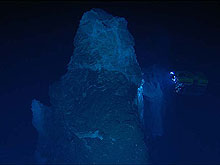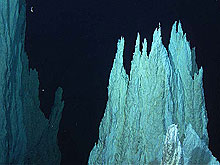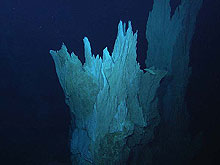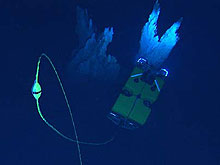
Remarkable view of the Nature Tower in the light of the IFE ROV Hercules. Click image for larger view and image credit.
Chimneys
July 31, 2005
Dr. Deborah Kelley
Co-Chief Scientist
As the ship prepares to leave the work site today, we again revisit some of the main, actively venting chimneys within the Lost City field. The massive edifices, shingled beehive-like structures, and growths reminiscent of inverted stalagmites have yielded a magical enchantment with this site, like no other yet visited. Viewed from 100 feet away, the chimneys are ghostly in appearance, bathed in a soft blue light bounded by the dark of the deep. The close up, high definition views provided by Hercules show us details of chimney growth, animals and microorganisms we have not seen before. We are grateful for this opportunity, and look forward to working with these data for a very long time in the search for new discoveries about how life is supported within this amazing, extreme environment.
 Top of the Poseidon
Top of the Poseidon
Dr. Mitch Schulte
Organic Geochemist
![]() Video
of Poseidon (Quicktime, 816 Kb)
Video
of Poseidon (Quicktime, 816 Kb)
The Poseidon structure is one truly massive mound of carbonate, and is so far the largest and oldest known hydrothermal feature in the Lost City vent field. It is greater than 60 meters (almost 200 feet) tall and consists of a multitude of active and inactive chimneys, flanges and spires. The IMAX flange and Beehive chimney grow out of the sides of the Poseidon structure. These features coalesce near the bottom, making Poseidon about 50 meters (about 164 feet) wide at its base.
The summit of the Poseidon structure consists of four major pinnacles. One is actively venting fluids at about 59° C (138° F) at its top. There are other active areas near the apex of this structure as well, including a saddle between peaks with fluid temperatures as high as 75° C. Minerals deposit out of the venting fluids, meaning that Poseidon is still growing!
Brighter white areas seen on the pinnacles are indicative of more newly formed material. As the carbonates age, they turn grayish or golden brown in color. Part of the reason is that over time, the carbonate mineral that first precipitates, called aragonite, converts to or gets replaced by a new mineral, calcite. Both aragonite and calcite have the same chemical composition but a different crystal structure. Another mineral that precipitates in the chimney walls, brucite, dissolves away as the chimneys interact with seawater. Different minor chemical elements also get incorporated into the carbonates through reactions with seawater, also accounting for some color change.
 The Nature Pinnacle
The Nature Pinnacle
Adelie Delacour
Geologist
Ph.D student
![]() Video
about the top of the Nature Tower (Quicktime, 1.6 Mb)
Video
about the top of the Nature Tower (Quicktime, 1.6 Mb)
![]() Video
about the lower part of the Nature Tower (Quicktime, 992 Kb)
Video
about the lower part of the Nature Tower (Quicktime, 992 Kb)
The Nature Pinnacle was one of the first chimneys imaged in 2000, during the discovery of the Lost City Field. During this NSF-funded expedition, the scientists used a small robot called Argo that acquired pictures of the ocean floor and the numerous carbonate chimneys composing Lost City. The mosaic of this structure made the cover of the "Nature" journal in 2001, leading to its name.
In 2003, the scientists returned to Lost City and located the Nature Pinnacle to the east of Poseidon, the largest structure within the field. This carbonate chimney is located along the NE-SW-trending East wall formed by a steep cliff of basement rocks. The top of this 20 m high structure is at 837 m (~2500 feet) water depth and its base lies directly on the serpentinite basement rocks at about 850 m.
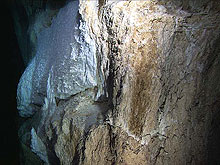
Fresh white beehive formation grows out of the brownish wall of Nature Tower. Click image for larger view and image credit.
This chimney is not a single spire, but has a more complex shape consisting of two massive spires that divide at the top. One has two fingers forming a V-shape and the other is composed of multiple small spires made of snow-white carbonate. Transparent fluids coming out from a small white spire at the Nature Pinnacle have a temperature around 63°C. At the base of this structure, the carbonates display a brown color attesting to an older age. Many old broken spires that fell down from the two main active structures are seen on the small terrace of basement rocks from which the chimney originates. In 2003, a marker was placed at the V-shaped spire to help recognize the structure. For this reason, Nature Pinnacle is also known as Marker H.
Sign up for the Ocean Explorer E-mail Update List.



























